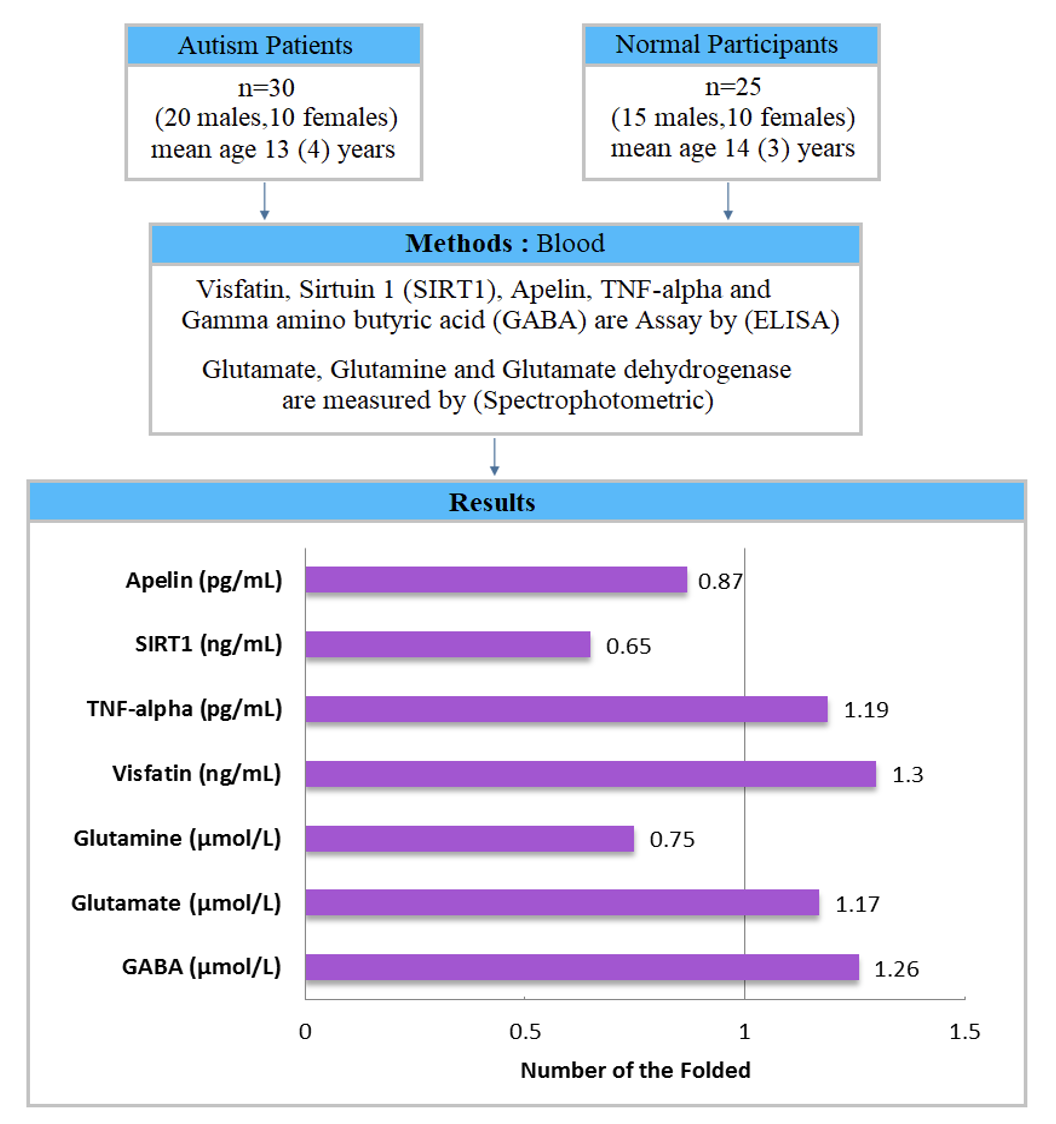Role of visfatin, sirtuin 1 and apelin in patients with autism disorder
DOI:
https://doi.org/10.18413/rrpharmacology.11.578Abstract
Introduction: Autism is one of the neurological disorders that vary in characters and degree of sternness. The aim of the study was to quantify the serum levels of some nitrogen metabolites, sirtuin 1, visfatin, apelin and tumor necrosis factor-alpha in autistic patients and to evaluate their levels in contrast to normal participants.
Materials and Methods: The study was conducted on 30 patients (20 males, 10 females) with autism, mean age 13 (4) years and 25 normal participants (15 males, 10 females), mean age 14 (3) years. The blood levels of visfatin, sirtuin 1, apelin, tumor necrosis factor-alpha, glutamate dehydrogenase, gamma aminobutyric acid, glutamate, and glutamine were analyzed in all participants by using different techniques according to the manufacturer.
Results: The statistical analyses of the data for the patients versus normal participants showed high prominent elevation in serum levels of visfatin (P=0.006), tumor necrosis factor-alpha(P=0.001), gamma aminobutyric acid (P=0.002), and glutamate (P=0.001). Conversely, high appreciable reductions were noted in serum levels of glutamine (P<0.001), sirtuin 1 (P=0.002),and apelin (P<0.001). Whereas non-momentous rise (P=0.083) was noted in serum level of glutamate dehydrogenase.
Conclusion: The reason of abnormal serum levels of some nitrogen metabolites, cytokines (visfatin, and tumor necrosis factor–alpha), sirtuin 1, and apelin may contribute to the pathoetiology of autism. Thereafter these results may be important for identifying new treatment approach for autism.
Graphical Abstract

Keywords:
autism, apelin, cytokines, glutamate dehydrogenase, nitrogen metabolites, sirtuin 1, visfatinReferences
Abu Shmais G, Al-Ayadhi L, Al-Dbass A, El-Ansary A (2012) Mechanism of nitrogen metabolism-related parameters and enzyme activities in the pathophysiology of autism. Journal of Neurodevelopmental Disorders 4(1): 4. https://doi.org/10.1186/1866-1955-4-4[PubMed] [PMC]
Bennuri SC, Rose S, Frye RE (2019) Mitochondrial dysfunction is inducible in lymphoblastoid cell lines from children with autism and may involve the TORC1 Pathway. Frontiers in Psychiatry 10: 269. https://doi.org/10.3389/fpsyt.2019.00269 [PubMed] [PMC]
Boso M, Emanuele E, Politi P, Pace A, Arra M, Nemi SU, Barale F (2007) Reduced plasma apelin levels in patients with autistic spectrum disorder. Archives of Medical Research 38(1): 70–74. https://doi.org/10.1016/j.arcmed.2006.08.003 [PubMed]
Bu X, Wu D, Lu X, Yang L, Xu X, Wang J, Tangm J (2017) Role of SIRT1/Pgc-1α in mitochondrial oxidative stress in autistic spectrum disorder. Neuropsychiatric Disease and Treatment 13: 1633–1645. https://doi.org/10.2147/NDT.S129081 [PubMed] [PMC]
Acikel SB, Artik A, Hosoglu E, Yerlikaya FH (2022) Serum Apelin-13 levels are decreased among adolescents diagnosed with major depressive disorder. Psychiatria Danubina 34(4): 677–681. https://doi.org/10.24869/psyd.2022.677 [PubMed]
Ciruela F, Casado V, Rodrigues RJ, Lujan R, Burgueno J, Canals M, Borycz J,N, Goldberg SR, Mallol J, Cortés A, Canela EI, López-Giménez JF, Milligan G, Lluis C, Cunha RA, Ferré S, Franco R (2006) Presynaptic control of striatal glutamatergic neurotransmission by adenosine A1-A2A receptor heteromers. Journal of Neuroscience 26(7): 2080–2087.https://doi.org/10.1523/jneurosci.3574-05.2006 [PubMed] [PMC]
Dhossche DM, Rout U (2006) Are autism and catatonic regression related? A few working hypotheses involving GABA, Purkinje cell survival, neurogenesis, and ECT. International Review of Neurobiology 72: 55-79. https://doi.org/10.1016/S0074-7742(05)72004-3[PubMed]
Fatemi SH (2008) The hyperglutamatergic hypothesis of autism. Progress in Neuro-Psychopharmacology and Biological Psychiatry 32(3): 912–913. https://doi.org/10.1016/j.pnpbp.2007.11.004 [PubMed]
§ Ferraro S, Saielli L, Biganzoli D, Tosi M, Guidi L, Longo R, Severino F, Carelli S, Rossi M, Pisciotta L, Ricci E, Brustia F, Verduci E, Zuccotti G, Mussap M, Cereda C (2025) Amino acid patterns in children with autistic spectrum disorder: a preliminary biochemical evaluation. Nutrients 17(2): 274. https://doi.org/10.3390/nu17020274 [PubMed] [PMC]
Ghaffari MA, Mousavinejad E, Riahi F, Mousavinejad M, Afsharmanesh MR (2016) Increased serum levels of tumor necrosis factor-alpha, resistin, and visfatin in the children with autism spectrum disorders: a case-control study. Neurology Research International. 2016: 9060751. https://doi.org/10.1155/2016/9060751 [PubMed] [PMC]
Haigis MC, Mostoslavsky R, Haigis KM, Fahie K, Christodoulou DC, Murphy AJ, Valenzuela DM, Yancopoulos GD, Karow M, Blander G, Wolberger C, Prolla TA, Weindruch R, Alt FW, Guarente L(2006) SIRT4 inhibits glutamate dehydrogenase and opposes the effects of calorie restriction in pancreatic beta cells. Cell 126(5): 941–954. https://doi.org/10.1016/j.cell.2006.06.057 [PubMed]
Han S, Tai C, Jones CJ, Scheuer T, Catterall WA (2014) Enhancement of inhibitory neuro-transmission by GABAA receptors having α2,3-subunits ameliorates behavioral deficits in a mouse model of autism. Neuron 81(6): 1282–1289. https://doi.org/10.1016/j.neuron.2014.01.016 [PubMed] [PMC]
Hashim F (2022) Compendious review on adipokines of corpulence. Research Journal of Pharmacy and Technology 15(9): 4315–4318. https://doi.org/10.52711/0974-360X.2022.00724
Kaczmarski P, Sochal M, Strzelecki D, Białasiewicz P and Gabryelska A (2023) Influence of glutamatergic and GABAergic neurotransmission on obstructive sleep apnea. Frontiers in Neuroscience 17: 1213971. https://doi.org/10.3389/fnins.2023.1213971 [PubMed] [PMC]
Kanavouras K, Mastorodemos V, Borompokas N, Spanaki C, Plaitakis A (2007) Properties and molecular evolution of human GLUD2 (neural and testicular tissue-specific) glutamate dehydrogenase.Journal of Neuroscience Research85(15): 3398–3406.https://doi.org/10.1002/jnr.21576 [PubMed]
Kemper J, Choi S, and Kim D (2013) Sirtuin 1 deacetylase: A key regulator of hepatic lipid metabolism. Vitamins and Hormones 91: 385–404. https://doi.org/10.1016/b978-0-12-407766-9.00016-x [PubMed] [PMC]
Lin YC, Wu HC, Liao CC, Chou YC, Pan SF, Chiu CN (2015) Secretion of one adipokine nampt/visfatin suppresses the inflammatory stress-induced nf-
Published
How to Cite
Issue
Section
License
Copyright (c) 2025 Rada F

This work is licensed under a Creative Commons Attribution 4.0 International License.
 Русский
Русский
 English
English

